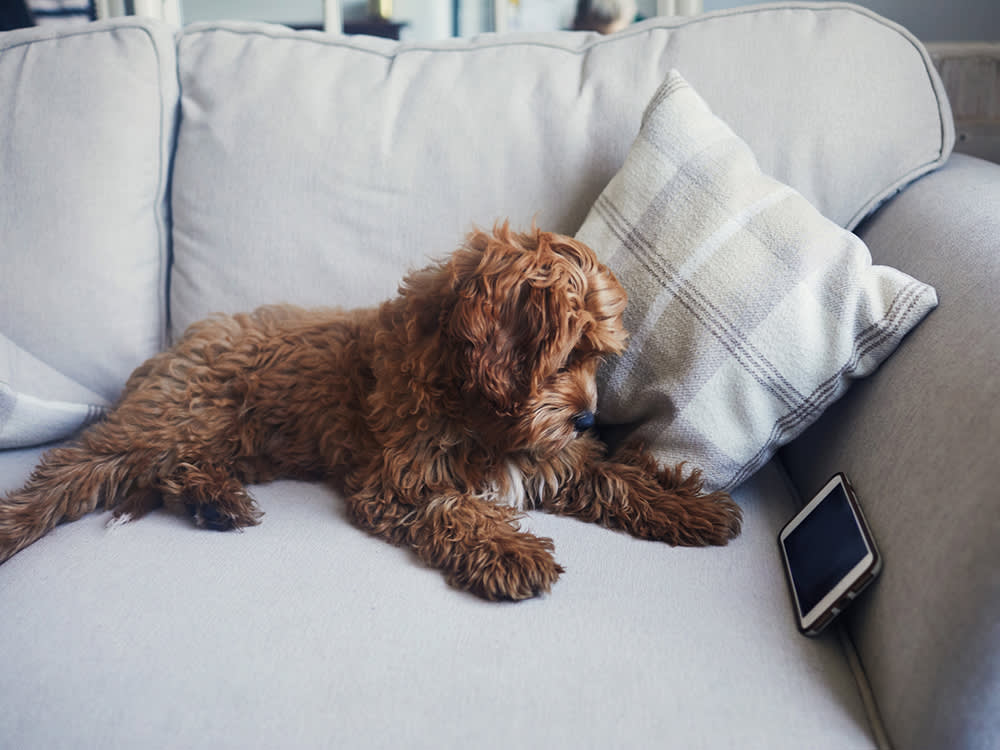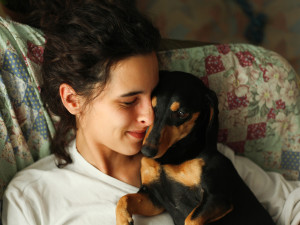New Phone, Who Dis?
Researchers at the University of Glasgow are testing a “DogPhone” that allows your pet to video-call you. We gave its architect, Dr. Ilyena Hirskyj-Douglas, a ring to hear more.

Share Article
We’ve all had that fantasy about being able to talk to our dogs. To finally be able to ask them simple questions about their days, if they’re happy, and what their actual beef is with the postal service. But, let’s be real, this hypothetical connection would be most useful when we’re not around. We could easily ring them up while at work to tell them, “Don’t worry, I’ll be home. Also, please don’t eat my new Vans.” While communication on that level is unfortunately impossible, phoning them from the office is far from it. In fact, such a device might be more realistic than me owning a pair of high-tops that aren’t chewed-up.
Dr. Ilyena Hirskyj-Douglas, a specialist in animal-computer interaction at the University of Glasgow’s School of Computing Science has developed a “DogPhone” that allows pets to call their owners while they’re away — though it’s not exactly a landline. The concept revolves around a softball inside which contains technology that can trigger a FaceTime-style chat when pressed.
“The system works by detecting when a dog moves the DogPhone ball device; it then signals this to my dog’s laptop, which is in our lounge. The laptop then sends a call to my phone and laptop where I can choose to answer the call,” explains Dr. Hirskyj-Douglas. “If I answer, then I appear on the screen in our lounge with video and audio. Likewise, my dog could answer the call if I rang him by moving the ball. In this way, it is both audio and visual-based.”
In recent years, there have been several attempts to create new technologies for pet parents to connect with their pups while they’re gone — from general surveillance cams to on-depend treat dispensers — but none have afforded dogs much control, if any. This disparity between who the devices were for and who managed them was very much at the heart of Dr. Hirskyj-Douglas’ inspiration to create the DogPhone. It was something she first considered after moving abroad and attempting to connect with her father’s dog.

“At the same time, I saw an increase in technologies made for dogs, especially technologies made for owners to video call their dogs,” she says. “I thought that the dogs do not really have much control over these technologies — they are used on them within their homes. So to flip this paradigm I started to think about creating a video call device that dogs can control themselves.”
Now before you envision a furrier Black Christmas reboot in which the calls are coming from inside the dog house, it’s important to note we’re still a ways away from this device being commercially viable. Dr. Hirskyj-Douglas and her team at the University of Glasgow only recently conducted their first study on the DogPhoneopens in new tab.
The research took place over a 16-day period and involved Dr. Hirskyj-Douglas giving her 10-year-old Labrador Retriever, Zack, the ability to call her by moving his DogPhone-enabled ball. During the testing period, Zack activated a call five times a day on average — more than 50 times in total. However, according to the study, nearly all instances were seemingly accidental.
And while the DogPhone could potentially help ease the increasing prevalence of separation anxiety in dogs, Dr. Hirskyj-Douglas makes it clear we’re not there yet. “Many people are interested in this as a product, but it is still in the developmental stages. For instance, this has only currently been used on my dog; there is much more work to do to see how this benefits a dog’s health, such as anxiety, and how this works across varying different species,” she explains.
Whether or not this current iteration of the DogPhone lives up to its lofty goals, Dr. Hirskyj-Douglas believes that this is the next step in the evolution of pet communication technology. “DogPhone really shows how the future of technology for dogs can look very different and be a technology that dogs can use of their own choice and control. This, to me, is the next era of pet technology,” she says.

Sean Zucker
Sean Zucker is a writer whose work has been featured in Points In Case, The Daily Drunk, Posty, and WellWell. He has an adopted Pit Bull named Banshee whose work has been featured on the kitchen floor and whose behavioral issues rival his own.
Related articles
![]()
What Are Dog Communication Buttons? And How to Use Them
Cognitive Science professor Dr. Federico Rossano on how Bunny, TikTok’s “talking” dog, is sparking change in how we communicate with our pets.
![Woman sitting with her dog outdoors]()
How to Talk to Your Dog, According to Science
Baby talk works on puppies. As for adult dogs, that’s still up for debate.
![Young woman hugging her small black dog on the couch]()
Who Has More Separation Anxiety — You or Your Dog?
It was a trick question. A study shows that the pandemic has made us all codependent.
![Muscular white pit bull stands on couch, looking out window to sunny fall day.]()
Separation Anxiety in Dogs
Does your dog freak out when you head for the door? Here’s some advice.



